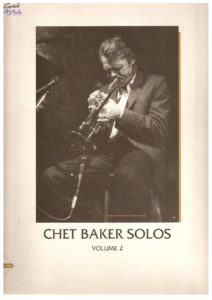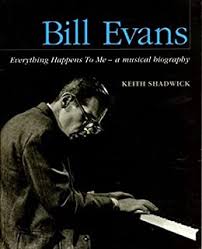Browse in the Library:
The Complete Legendary Sessions
Chet Baker and Bill Evans – “How high the Moon” with sheet music download

Lyrics
Somewhere there’s music
How faint the tune
Somewhere there’s heaven
How high the moon
There is no moon above
Love is far away too
‘Til it comes true
That you love me as I love youSomewhere there’s music
How near, how far
Somewhere there’s heaven
It’s where you are
The darkest night would shine
If you would come to me soon
Until you will, how still my heart
How high the moonAah-aah-aah-aah-aah-aah-aah-aah-aahSomewhere there’s music
How faint the tune
Somewhere there’s heaven
How high the moon
The darkest night would shine
If you would come to me soon
Until you will, how still my heart
How high the moon
“How High the Moon” is a jazz standard with lyrics by Nancy Hamilton and music by Morgan Lewis. It was first featured in the 1940 Broadway revue Two for the Show, where it was sung by Alfred Drake and Frances Comstock. In Two for the Show, this was a rare serious moment in an otherwise humorous revue.
Chet Baker & Bill Evans: a short Biography
Never have two musicians seemed so alike in temperament yet differed so much in their approach to making music as Chet Baker and Bill Evans. While both were peerless masters of their instruments and shared a rich, evocatively lyrical playing style that bordered beguilingly on the introspective, Baker and Evans were polar opposites when it came to the discipline of performance.
Though both were heroin addicts, the musically-trained Evans never let it interfere with his meticulously precise flights of invention while the self-taught Baker became increasingly erratic and inconsistent. They ventured into a recording studio together on just three occasions, with largely disappointing results, their potentially combustible collaboration failing to ignite and all too frequently sounding workmanlike and uninspiring.
The Complete Legendary Sessions corrals the 15 tracks that resulted from those sessions – previously issued on two 1959 albums: Chet, and Chet Baker Plays the Best of Lerner and Loewe – together for the first time, with a vocals-free Baker concentrating on his horn playing.
Occupying the first 10 tracks (absent from the LP release, Early Morning Mood appears here as a welcome bookend) Chet turns in satisfyingly laidback but unexciting performances. Sparks of energy are provided by Herbie Mann’s flute, the baritone sax of Pepper Adams, Connie Kay and Philly Joe Jones on percussion, guitarist Kenny Burrell and bass man Paul Chambers, who all go about their business with a winningly insouciant confidence.
Album opener Alone Together continues to cast a shimmering, dark-hued spell half a century later, Baker breathing long, lingering, hypnotic lines that flex and flow with understated panache. The prevailing mood is melancholic and down-tempo, with the virtually somnambulant Baker and overly cautious Evans remaining curiously semi-detached from each other throughout.
The Lerner and Loewe material offers livelier fare, but Baker remains strangely subdued and understatement continues to be Evans’s default even in the love-lit delirium of I Could Have Danced All Night. A bonus cover of Almost Like Being in Love sways rather than swings, with Bob Corwin stepping in for Evans.
As a glimpse of what might have been had these two been on form, this tantalises and frustrates in equal measure.
Songs based on “How High the Moon”
Another jazz standard, “Ornithology” by Charlie Parker, is based on the chords of “How High the Moon”. It was common among jazz musicians (Ella Fitzgerald, Lionel Hampton and others) to seamlessly include “Ornithology” in the solo when performing “How High the Moon”. Lennie Tristano wrote the contrafact “Lennie-bird” over the chord changes, and Miles Davis/Chuck Wayne‘s “Solar” is also based on part of the chord structure. Coleman Hawkins’ tune “Bean At Met” is also based on the changes of How High The Moon; this tune starts with simple riffs on the measures 1 to 8 and 17 to 24. The rest is filled up with solos.
John Coltrane‘s composition “Satellite” is also based on the chords of “How High the Moon”, which Coltrane embellished with the three-tonic progression he also used on his composition “Giant Steps“.
Jimmy Giuffre‘s composition “Bright Moon” is also based on the chords of “How High the Moon”. Quincy Jones recorded it in 1957 on his second album, Go West, Man!
The Complete Legendary Sessions (Chet Baker & Bill Evans)
Never have two musicians seemed so alike in temperament yet differed so much in their approach to making music as Chet Baker and Bill Evans. While both were peerless masters of their instruments and shared a rich, evocatively lyrical playing style that bordered beguilingly on the introspective, Baker and Evans were polar opposites when it came to the discipline of performance.
Though both were heroin addicts, the musically-trained Evans never let it interfere with his meticulously precise flights of invention while the self-taught Baker became increasingly erratic and inconsistent. They ventured into a recording studio together on just three occasions, with largely disappointing results, their potentially combustible collaboration failing to ignite and all too frequently sounding workmanlike and uninspiring.
The Complete Legendary Sessions corrals the 15 tracks that resulted from those sessions – previously issued on two 1959 albums: Chet, and Chet Baker Plays the Best of Lerner and Loewe – together for the first time, with a vocals-free Baker concentrating on his horn playing.
Occupying the first 10 tracks (absent from the LP release, Early Morning Mood appears here as a welcome bookend) Chet turns in satisfyingly laidback but unexciting performances. Sparks of energy are provided by Herbie Mann’s flute, the baritone sax of Pepper Adams, Connie Kay and Philly Joe Jones on percussion, guitarist Kenny Burrell and bass man Paul Chambers, who all go about their business with a winningly insouciant confidence.
Album opener Alone Together continues to cast a shimmering, dark-hued spell half a century later, Baker breathing long, lingering, hypnotic lines that flex and flow with understated panache. The prevailing mood is melancholic and down-tempo, with the virtually somnambulant Baker and overly cautious Evans remaining curiously semi-detached from each other throughout.
The Lerner and Loewe material offers livelier fare, but Baker remains strangely subdued and understatement continues to be Evans’s default even in the love-lit delirium of I Could Have Danced All Night. A bonus cover of Almost Like Being in Love sways rather than swings, with Bob Corwin stepping in for Evans.
As a glimpse of what might have been had these two been on form, this tantalises and frustrates in equal measure. Version 1, edited by VaMpkt on 8 April 2011, 1:24pm · View version history

